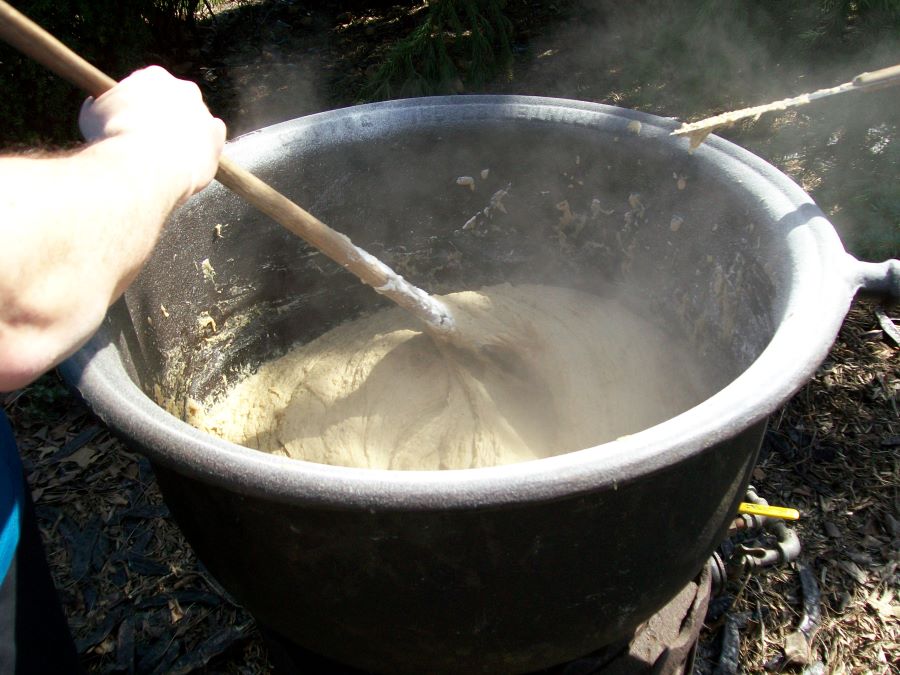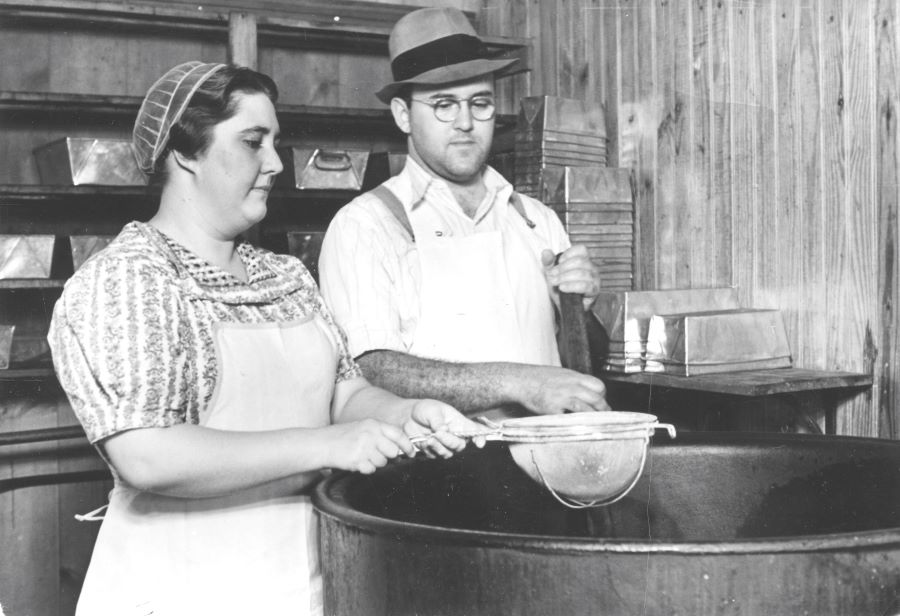By Bob Wood.
Title image: This butchering day in Milford Township, Bucks County looks cold, wet, muddy and miserable. Mennonite Heritage Center Collection.
In the old Pennsylvania Dutch days, cold winter weather was the time for butchering. At the end of butchering day or sometimes the next day, the pork leavings were processed into scrapple.
Of scrapple, a 1905 essay in the New York Sun by Dr. David Rittenhouse Bingham rhapsodizes: “The Pennsylvania Dutch have many solid and useful qualities and one of the most engaging languages known to man; as the inventors of scrapple they have conferred upon Philadelphia and the rest of the world a priceless boon.”
So taken is he with scrapple that he then breaks into verse:
“Oh flower of all the flavors, O Queen of all the savors
That e’er to happy nostrils deliciously have rolled!
My soul with rapture shivers when I see the perfect slivers
of kidney blent with livers, the scrapple hot or cold.”
As the name seems to suggest, scrapple is made from pork scraps, and cooking it was among the final events on the Dutchmen’s butchering day. The pork scraps from butchering and most of the remaining pig parts such as the tongue, liver, bits of skin, meat scraped off the head, bones, and whatever else are boiled in a large iron kettle for a good long time. The contents of the kettle (minus the bones), the broth from the cooked meat, along with buckwheat flour and cornmeal for thickening are then boiled together and finally poured into rectangular pans to solidify into loaves which are later sliced and fried as a breakfast dish.

The scrapple, as it is cut from the loaf, is an unappetizing gray color, but fried it turns a golden brown. Any number of toppings are slathered onto the fried scrapple slices: molasses, maple syrup, apple butter, cottage cheese, anything…but please, not ketchup.
Gehman’s scrapple recipe
The following recipe from Bob and Addie Gehman of Coopersburg provides a good description of the steps in traditional scrapple making:
In a large kettle or farmer’s boiler, over a good fire, cook pork bones, heart, liver, and any other meat until the meat falls off the bones. Stir often. Dip meat out and onto a tray and let it cool until it can be picked off the bones. Sort meat from bones; discard bones and grind meat. Dip broth from kettle and strain to remove any bones. Measure the broth. Lower the fire. Combine:
½ part ground meat
½ part broth
⅛ lb pepper to taste
2-3 tbsb. salt
Handful of coriander
Extra hog fat if pork is lean
4 lb. cornmeal added when the above is hot
Heat to boiling and cook 15 minutes, stirring constantly. Add six pounds of buckwheat flour gradually (sprinkle by hand slowly and stir so lumps do not form). Cook until boiling. Add whole wheat flour as needed to thicken. Entire contents will separate from sides of pot. Quickly scoop scrapple onto pans and let cool.

Scrapple or panhaas?
Of course there is a great variation in scrapple recipes. Some omit the liver. Some have more or less of various seasonings. Historian Alan Keyser notes that this is a “coriander belt” of Pennsylvania Dutch food. Sage is the seasoning of choice west of this area in Lancaster and York Counties.
As to the word itself, “scrapple” is obviously English. In fact there is no PA Dutch word for scrapple. Perhaps the word evolved as the Dutchmen “stood market” in Philadelphia. The product was known far and wide as Philadelphia Scrapple.
The closest PA Dutch word to scrapple is “panhaas” which dish is basically scrapple without the meat. The boiling pork stock is thickened with a mixture of buckwheat flour and cornmeal. Ladled into pans, it congeals when cool and is fried like scrapple.
Goschenhoppen Historian Bob Wood has researched, written and spoken extensively about PA Dutch folk culture topics and can be found at the Antes House during the Goschenhoppen Folk Festival.

Great article. Will I be forgiven for liking ketchup on scrapple?
LikeLiked by 1 person
NO KETCHUP
LikeLike
You can be forgiven, but you might hear the added “She chust doessn’t know better!” Actually, ketchup is fine, but made even better if horseradish is added – maybe even some chopped raw onion in addition……….Now, having read these posts again, I’m thinking how sad it is that this Virginia retirement community doesn’t have Scrapple in its menu!
LikeLike
i like ketchup on my scrapple sandwich , on one slice of bread and mayo on the other side of bread, and toast the bread please,
LikeLike
Mayo on scrapple!! I want horseradish, thank you very much! That’s even more important than catsup – and come to think of it, cocktail sauce would be the same thing as catsup and horseradish mixed. I MIGHT be tempted to try mayo the next time we’re at Village Inn for breakfast buffet! Thanks for writing -Audrey
LikeLike
Actually, my Mom always put molasses – NOT the strong stuff – on the table for us to spread on our bread as an accompaniment to the slices of scrapple. Man, would I like to sit at that kind of table again!!
LikeLike
My Uncle John used to make the best scrapple. I hated scrapple until I tasted his. To this day I won’t eat scrapple because I know it won’t be as good as his was!
LikeLiked by 1 person
You should have asked him for the recipe so you can make it yourself
LikeLike
Personally I like to scrapple that we get out here at the farmers Amish Farmers market. There’s just something they do that makes it special
LikeLike
I used to like it with Ketchup, but across the years I’ve become increasingly fond of it with maple syrup. My Irish husband has become a great devotee of scrapple. I think it’s rather like the White Pudding found in Ireland. — These days we love Bolton’s in Silverdale Turkey Scrapple. I’m curious to know about the coriander belt and if it’s still the case that coriander is used here in the area near Franconia and Goschenhoppen? I always imagined it was seasoned with sage, but I’ve not read the ingredients to local versions.
LikeLike
My father and us kids you to make scrapple on the farm 60 70s and 80s just like this cooked it in a Black Kettle over a wood fire and stirred it with a stick love eating homemade scrapple we also made pot wash
LikeLike
What is pot wash?
LikeLike
I think you’re right – sage was more often used. My preacher-father was also a cattle grower and butcher and when we had scrapple other than what he had mixed and cooked for years, we frequently heard his judgement that they “use too much sage.”! Thanks for bringing back the memories of his expertise with meats – growing them, butchering the right cuts for what occasion, and the preparation of them for us, his family. I grew up knowing “a good cut of meat” as a result of Pop’s knowledge of such!
LikeLike
My father, Clarence Arndt, or Asher, as known to some, made some of the best scrapple in the Vera Cruz Upper Milford Township area. Almost yearly we butchered a pig and steer in his garage. He had all the butchering tools, large cast iron pots, and kiln, etc. We had a quite a sale in June 1992 of all of his “gear” which netted my mother a nice sum. He was somewhat renowned for his wares and abilities. I miss that scrapple, although I found some that comes close up in Weissport last year I was told came from a Bowmanstown area butcher. Don’t recall the name.
LikeLike
Waterman’s in Hereford makes some darn good scrapple! I’m also an applebutter fan, but sometimes a good dippy egg on top is good too. I’m intrigued about the molasses!
LikeLiked by 1 person
Coriander, interesting. I need to try that. I got a tip years ago to use savory and sage as the flavoring. Does anyone know what Hatfield or Habbersett uses?
LikeLike
Sorry, but the correct PA Dutch name for scrapple is panhaas. It wasn’t until college I learned of the name scrapple. Maybe there is someone somewhere that makes meatless scrapple with broth and refers to it as panhaas, but that is a total anomaly. Despite the prevalence of the use of the word scrapple, the correct dialect name is panhaas, and the recipe includes meat.
LikeLike
Thanks for your insightful comment. Scrapple is not a PD word. If you are familiar with Richard Beam’s “Comprehensive Pennsylvania German Dictionary (in 12 volumes) you can note that he writes extensively about Paanhass. Indeed, his definition of Paanhaas is “scrapple.” There is no entry under “scrapple” as, noted, it’s not a PD word.
In short, there are plenty of primary source references in Dutch which describe Paanhaas made with meat and all the ingredients that we call scrapple; and plenty of references to Paanhaas being just the liquid left over after cooking the meat with buckwheat and cornmeal added to thicken.
Beam notes that “There has been more surmise and discussion about the origin of this word than about that of any other word in the dialect.”
In any case, thanks again for your quite accurate comment.
LikeLike
And it’s really meat that is tight to the bone and its beef and pork not just pork. My family still makes it. Not my direct family anymore since we sold our farm. My cousins still do. I found 1 place that has similar to ours peters brothers meats in lenhartsville, la. And the only acceptable items for on it in our family are apple butter or molasses
LikeLike
I grew up in Montgomery County, always hearing there was a difference in the two, and thought everybody who grew up eating Scrapple knew there was a BIG difference! Guess we all have our cultural, culinary biases!
LikeLike
Thanks for your commentary Bob. I just wanted to make sure we were not headed down a path that makes an Anglo distinction of defining scrapple versus its PA Dutch origin as paanhaas. Whether you use meat or broth, it is merely a variation of the same thing and the semantics don’t distinguish a particular mindset of how the dish is made.
LikeLike
Paanhaas or scrapple, that is the question, at least here in the comments : ) I’m from Central PA (White topper amish country), I was under the impression that Paanhaas was made with buckwheat and scrapple corn meal. OK, I don’t have a lot of detail about that, it’s just what I remember as a kid. We’ll save the head cheese / souse conversation for another day : )
LikeLike
I would LOVE to hear the Panhass/head cheese/souse discussion!
As to the “Irish pudding” – uhUH! No comparison! When I first ate it in Ireland, much as I loved Ireland – my only thought was “Well, they haven’t tasted my Pop’s Scrapple 🙂
LikeLike
I’m a Berks County Pa Dutch woman living in Texas. I sure do miss scrapple.
LikeLiked by 1 person
I wish I knew the ratio of meat and broth to corn meal and flour in the recipe
LikeLike